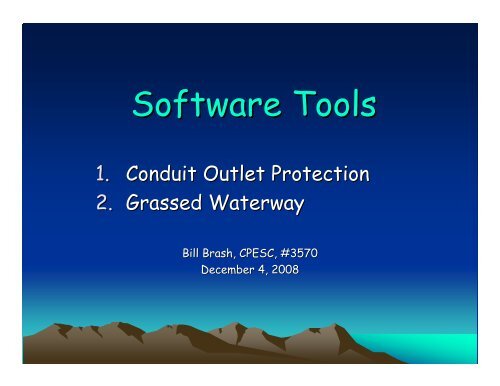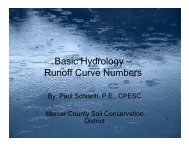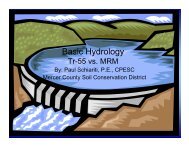Conduit Outlet & Grassed Waterway Software Tools PowerPoint ...
Conduit Outlet & Grassed Waterway Software Tools PowerPoint ...
Conduit Outlet & Grassed Waterway Software Tools PowerPoint ...
You also want an ePaper? Increase the reach of your titles
YUMPU automatically turns print PDFs into web optimized ePapers that Google loves.
<strong>Software</strong> <strong>Tools</strong><br />
1. <strong>Conduit</strong> <strong>Outlet</strong> Protection<br />
2. <strong>Grassed</strong> <strong>Waterway</strong><br />
Bill Brash, CPESC, #3570<br />
December 4, 2008
<strong>Conduit</strong> <strong>Outlet</strong> Protection<br />
• “Conditions Where Practice Applies”<br />
– Where a conduit restricts design flow<br />
• Design Criteria<br />
– Allowable velocity of soil type is exceeded (Table 12-1)<br />
– 25 year or design storm whichever is greater<br />
• Excel Spreadsheet Provides Easy Design Checks for<br />
These <strong>Outlet</strong> Scenarios.<br />
– Flat Apron: No defined waterway downstream.<br />
– Scour Hole: No defined waterway, length of apron<br />
restricted.<br />
– Existing channel: Discharge to defined waterway or ditch. *
Definitions<br />
• Do: Maximum inside<br />
culvert height in<br />
feet.<br />
• Tw: Tailwater, depth<br />
of receiving water<br />
above invert.<br />
– Not known or not<br />
provided = (.2) Do.
Flat Apron-Design Apron Design Equations-Length<br />
Equations Length<br />
For <strong>Conduit</strong> of 15” (1.25 ‘) and a Q of 10 cfs<br />
Tw < ½ Do……….. length = 21.63 feet where Tw is .25’<br />
Tw > ½ Do……….. length = 21.47 feet where Tw is 1.25’<br />
•Two separate equations for<br />
determining length for a flat<br />
apron.<br />
Tw < ½<br />
Do<br />
Tw > ½<br />
Do<br />
Why do we<br />
calculate<br />
length first?
Flat Apron-Design Apron Design Equations-Width<br />
Equations Width<br />
For <strong>Conduit</strong> of 15” (1.25 ‘) and a Q of 10 cfs and Wo’ = inside width of pipe<br />
Tw < ½ Do……….. width = 25.38 feet where Tw is 0.25’ Width at the<br />
end of apron<br />
Tw > ½ Do……….. length = 12.34 feet where Tw is 1.25’<br />
Width at <strong>Outlet</strong> = 3 Wo
Flat Apron-Design Apron Design Equation-d50<br />
Equation d50<br />
For <strong>Conduit</strong> of 15” (1.25 ‘) and a Q of 10 cfs<br />
Where Tw is .25’………. d50 = 1.02 feet<br />
Where Tw is 1.25’……... d50 = 0.20 feet or 2.5”
Flat Apron-Design Apron Design Criteria<br />
Special Circumstances<br />
S < ¼ Wo d50 and length<br />
as per 1 pipe.<br />
S > ¼ Wo d50 and length<br />
and increase values by<br />
1.25.<br />
For varying diameter<br />
outlets use largest values.<br />
If S >1/4 Wo…… increase<br />
values by 1.25.
Flat Apron-Design Apron Design Criteria<br />
• Thickness of Apron<br />
– 2 times d50 with filter fabric<br />
– 3 times d50 w/o filter fabric<br />
• Apron is constructed at 0.0% slope<br />
• There can be no “overfall” from the end of<br />
apron to existing grade<br />
• For Discharges into Detention Basins<br />
–25 year storm Q<br />
– Tw is equal to 2-year storm elevation in basin
COP Flat Apron Design Check<br />
PROJECT NAME: ANALYSIS PERFORMED BY:<br />
PROJECT NUMBER: DATE:<br />
<strong>Conduit</strong> <strong>Conduit</strong> <strong>Conduit</strong> Depth of Apron Apron Apron Median Apron Apron<br />
FES / Height Width Flow Tailwater Length Width Width at Stone Thickness Thickness<br />
HEADWALL (D O ) (W O ) (Q) (Tw) (La) (Wa) <strong>Outlet</strong> Diameter (Ta) in FT. (Ta) in FT.<br />
No. in FT. in FT. in CFS in FT. in FT. in FT. (Wa1) in FT. (d 50 ) in FT. w/o Filter w/ Filter<br />
#DIV/0! #DIV/0! 0.00 #DIV/0! #DIV/0! #DIV/0!<br />
#DIV/0! #DIV/0! 0.00 #DIV/0! #DIV/0! #DIV/0!<br />
#DIV/0! #DIV/0! 0.00 #DIV/0! #DIV/0! #DIV/0!<br />
#DIV/0! #DIV/0! 0.00 #DIV/0! #DIV/0! #DIV/0!<br />
#DIV/0! #DIV/0! 0.00 #DIV/0! #DIV/0! #DIV/0!<br />
#DIV/0! #DIV/0! 0.00 #DIV/0! #DIV/0! #DIV/0!<br />
#DIV/0! #DIV/0! 0.00 #DIV/0! #DIV/0! #DIV/0!<br />
#DIV/0! #DIV/0! 0.00 #DIV/0! #DIV/0! #DIV/0!<br />
#DIV/0! #DIV/0! 0.00 #DIV/0! #DIV/0! #DIV/0!<br />
#DIV/0! #DIV/0! 0.00 #DIV/0! #DIV/0! #DIV/0!<br />
#DIV/0! #DIV/0! 0.00 #DIV/0! #DIV/0! #DIV/0!<br />
#DIV/0! #DIV/0! 0.00 #DIV/0! #DIV/0! #DIV/0!<br />
•Input data from COP<br />
calculations in the table<br />
provided.<br />
•Will calculate length, width,<br />
d50, and thickness with or<br />
without filter fabric.<br />
•Will calculate COP for<br />
elliptical pipe.
Scour Hole Design Check<br />
PREFORMED SCOUR HOLE CALCULATION SPREADSHEET<br />
PROJECT NAME: 0 ANALYSIS PERFORMED BY: 0<br />
PROJECT NUMBER: 0 DATE: 1/0/1900<br />
<strong>Conduit</strong> <strong>Conduit</strong> <strong>Conduit</strong> Depth Depth of Scour Hole Dimensions Median Apron Apron<br />
FES / Height Width Flow to Scour Stone Thickness Thickness<br />
HEADWALL (D O ) (W O ) (Q) Tailwater Hole "A" "B" "C" Diameter (Ta) in FT. (Ta) in FT.<br />
No. in FT. in FT. in CFS in FT. in FT. in FT. in FT. in FT. (d 50 ) in FT. w/o Filter w/ Filter<br />
0.00 0.00 0.00 #DIV/0! #DIV/0! #DIV/0!<br />
0.00 0.00 0.00 #DIV/0! #DIV/0! #DIV/0!<br />
0.00 0.00 0.00 #DIV/0! #DIV/0! #DIV/0!<br />
0.00 0.00 0.00 #DIV/0! #DIV/0! #DIV/0!<br />
0.00 0.00 0.00 #DIV/0! #DIV/0! #DIV/0!<br />
0.00 0.00 0.00 #DIV/0! #DIV/0! #DIV/0!<br />
0.00 0.00 0.00 #DIV/0! #DIV/0! #DIV/0!<br />
0.00 0.00 0.00 #DIV/0! #DIV/0! #DIV/0!<br />
0.00 0.00 0.00 #DIV/0! #DIV/0! #DIV/0!<br />
0.00 0.00 0.00 #DIV/0! #DIV/0! #DIV/0!<br />
0.00 0.00 0.00 #DIV/0! #DIV/0! #DIV/0!<br />
• Will check scour hole design<br />
for Y=Do or Y= 1/2Do,<br />
where Y is the depth of the<br />
scour hole desired.<br />
•Will provide design check for<br />
length, width, d50 and thickness<br />
with or without filter fabric.<br />
•Will calculate scour hole<br />
dimensions for elliptical pipe.
Existing Channel COP Design Check<br />
CHANNEL CONDUIT OUTLET PROTECTION CALCULATION SPREADSHEET<br />
PROJECT NAME: 0 ANALYSIS PERFORMED BY: 0<br />
PROJECT NUMBER: 0 DATE: 1/0/1900<br />
<strong>Conduit</strong> <strong>Conduit</strong> <strong>Conduit</strong> Depth Depth Apron Median Apron Apron Greater of Min. Depth<br />
FES / Height Width Flow From of Length Stone Thickness Thickness 2 / 3 D O or of Riprap<br />
HEADWALL (D O ) (W O ) (Q) T.O.B. to Tailwater (La) Diameter (Ta) in FT. (Ta) in FT. 1 ft.+ Tw Above<br />
No. in FT. in FT. in CFS Invert in FT. (Tw) in FT. in FT. (D 50 ) in FT. w/o Filter w/ Filter in FT. Invert in FT.<br />
#DIV/0! #DIV/0! #DIV/0! #DIV/0! 1.00 0.00<br />
#DIV/0! #DIV/0! #DIV/0! #DIV/0! 1.00 0.00<br />
#DIV/0! #DIV/0! #DIV/0! #DIV/0! 1.00 0.00<br />
#DIV/0! #DIV/0! #DIV/0! #DIV/0! 1.00 0.00<br />
#DIV/0! #DIV/0! #DIV/0! #DIV/0! 1.00 0.00<br />
#DIV/0! #DIV/0! #DIV/0! #DIV/0! 1.00 0.00<br />
#DIV/0! #DIV/0! #DIV/0! #DIV/0! 1.00 0.00<br />
#DIV/0! #DIV/0! #DIV/0! #DIV/0! 1.00 0.00<br />
#DIV/0! #DIV/0! #DIV/0! #DIV/0! 1.00 0.00<br />
#DIV/0! #DIV/0! #DIV/0! #DIV/0! 1.00 0.00<br />
#DIV/0! #DIV/0! #DIV/0! #DIV/0! 1.00 0.00<br />
#DIV/0! #DIV/0! #DIV/0! #DIV/0! 1.00 0.00<br />
•Will provide design check<br />
for proposed outlets<br />
discharging into existing<br />
channels<br />
•Will provide Length, d50,<br />
Thickness with or without<br />
filter fabric.<br />
•Will provide the height of<br />
the armor protection in<br />
the channel in lieu of<br />
width.
Grass <strong>Waterway</strong>s<br />
• Conditions Where Practice Applies<br />
– Drainage areas < 200 acres<br />
– The slope of the waterway cannot exceed 10%<br />
– Do not apply this Standard if grass cannot be<br />
maintained.<br />
• Design Criteria<br />
– 10 year frequency storm for capacity and<br />
stability
Design Criteria<br />
“as as Brought Down From the Mountain”<br />
Mountain
The 2nd Stone Tablet<br />
Website for Texas DOT<br />
http://www.txdot.gov/publications/maintenance/approved_products_list_08.pdf
Grass <strong>Waterway</strong>s Design Check<br />
Project Name: Prepared By: Developed by: Paul Schiariti, P.E.<br />
Project Number: Date: Mercer County Soil Conservation District<br />
<strong>Grassed</strong> <strong>Waterway</strong> Calculator - Version 1.0 Beta Test For use by NJ Soil Conservation Districts<br />
1. Choose the Soil Texture: 2 Choose the Stabilization Method: Seeded Max<br />
Silt Loam, Sandy Loam, Loamy Sand, Muck<br />
1<br />
Seeded<br />
Sod Allowable<br />
Velocity<br />
Sand Allowable Velocity: 2.00<br />
Silt Loam, Sandy Loam, Loamy Sand, Muck Soil Texture: Silt Loam, Sandy Loam, Loamy Sand, Muck 1.12 1.77 5.00<br />
Silty Clay Loam, Sandy Clay Loam Stabilization Method: Seeded 5.50<br />
Clay, Clay Loam, Sandy Clay, Silty Clay Allowable Velocity: 2.00 FPS (No Channel Liner) 6.00<br />
Note: The allowable velocity given above does not consider the 3.00<br />
installation of a flexible channel liner. However, the computations 3.00<br />
below do consider the installation of flexible channel liners. 4.00<br />
5.00<br />
Veg. Ret. 4 5<br />
2. Choose Vegetal Retardance for Capacity: Choose Vegetal Retardance for Stability: Comp V 1.119385 1.765529<br />
Vegetal Retardance D<br />
Vegetal Retardance A<br />
Vegetal Retardance E<br />
Max All V<br />
Froude No.<br />
5.00<br />
0.32<br />
5.00<br />
0.58<br />
Vegetal Retardance B Vegetal<br />
Vegetal Retardance C Retardance Retardance Description:<br />
Vegetal Retardance D A Very High Vegetal Retardance<br />
Vegetal Retardance E 4 5 B High Vegetal Retardance<br />
Note: The values required for the analysis of <strong>Grassed</strong> C Moderate Vegetal Retardance<br />
<strong>Waterway</strong>s per The STANDARDS are: D for Capacity D Capacity- Low Vegetal Retardance<br />
and E for Retardance. E Stability- Very Low Vegetal Retardance<br />
Channel Data Input<br />
3. Enter the Channel Cross-Section:<br />
Trapezoidal<br />
Triangular<br />
Parabolic<br />
Parabolic<br />
3<br />
• Input Soil Texture<br />
• Input Stabilization<br />
method<br />
Seed<br />
Sod<br />
• Input Retardance<br />
Factor for Capacity<br />
• Input Retardance<br />
Factor for Stability<br />
• Input Channel<br />
Cross Section Type:<br />
P<br />
ar<br />
a<br />
b<br />
oli<br />
c
6. Input Parabolic Channel Geometry Parameters: 0<br />
0<br />
H Swale ID H Swale No.:<br />
15.00 Top Width in Feet ( T ) 15.00<br />
2.00 Depth in Feet ( d ) 2.00<br />
0.0100 Longitudinal Slope in Ft / Ft<br />
10.00 Design Flow Q in CFS<br />
D E 0 #REF!<br />
Vegetal Q 10.02 10.00<br />
RetardanceTW 9.88 8.81<br />
Y 0.88 0.70<br />
V 1.73 2.43<br />
Analysis Results: 2 2<br />
Vegetal Retardance: D<br />
The Computed Depth is not within 10% of Crit. Depth<br />
The Computed Vel. is less than the Allowable Vel. - Design is O.K.<br />
Vegetal Retardance: E<br />
The Computed Depth is not within 10% of Crit. Depth<br />
However, the Computed Vel. is greater than the Allowable Vel.<br />
a Type E min. classification of flexible channel liner is required<br />
Warning! Potential for a Hydraulic Jump Exists! Consider revising the Design.<br />
Vegetal<br />
Retardance<br />
D<br />
Swale No.:<br />
H<br />
Vegetal<br />
Retardance<br />
E<br />
Swale No.:<br />
Parabolic Cross section data input includes:<br />
•Top width in feet<br />
•Depth of Channel in Feet<br />
•Slope of grass waterway<br />
•Design Q<br />
PARABOLIC SECTION<br />
(Not To Scale)<br />
Design Top Width "T" = 15.00<br />
CHANNEL WIDTH ( t )<br />
Design Depth "D" = 2.00<br />
AT WATER SURFACE IN FT. = 9.88<br />
0<br />
FLOW DEPTH ( Y ) IN FT. = 0.88<br />
At 10.02 cfs<br />
0<br />
V avg = 1.73<br />
PARABOLIC SECTION<br />
(Not To Scale)<br />
Design Top Width "T" = 15.00<br />
CHANNEL WIDTH ( t )<br />
Design Depth "D" = 2.00<br />
AT WATER SURFACE IN FT. = 8.81<br />
FLOW DEPTH ( Y ) IN FT. = 0.70<br />
At 10.00 cfs<br />
V avg = 2.43<br />
H 0<br />
0
Project Name: KNF Neuberger Prepared By: WFB<br />
Project Number: 0 Date: 3/10/08<br />
Output Screens<br />
Detailed Hydraulic Analysis<br />
Channel Geometry: Parabolic Cross Section<br />
Swale No.: H<br />
Top Width in Feet - T 15.00<br />
Depth in Feet - D 1.00<br />
Longitudinal Slope in Ft / Ft 0.0150<br />
Longitudinal Slope in Percent (%) 1.50%<br />
Soil Texture Silt Loam, Sandy Loam, Loamy Sand, Muck<br />
Allowable Velocity in FPS (No Liner) 2.00 3<br />
a Type E Even with Even with Even with<br />
Hydraulic Computations:<br />
CAPACITY STABILITY<br />
Vegetal Retardance D E<br />
Computed Q in CFS 5.012 5.015<br />
Flow Depth "Y" in Feet 0.59 0.43 Design "Y" is within 10% of Critical Depth!<br />
Top Width "TW" in Feet at the water surface 11.42 9.81 Less than min. top width of 10 ft.<br />
Cross Sectional Flow Area "A" in FT 2<br />
4.477 2.840<br />
Wetted Perimeter "WP" in Feet 11.55 9.91<br />
Hydraulic Radius "R" 0.387 0.287<br />
Manning's Roughness Coefficient "n" 0.0864 0.0448 5.00 5.00<br />
Average Velocity "V" in FPS 1.12 1.77 Exceeds Maximum Allowable Velocity of: 5.00 FPS<br />
Froude Number "F" 0.315 0.578 Warning! Potential for Hydraulic Jump Exists!<br />
Critical Velocity "V crit" 2.66 2.66 Consider Revising the Design.<br />
10% of "Y crit" 0.033 0.033 0.361 2 2<br />
Critical Depth "Y crit" 0.328 0.328 0.296<br />
Flow Regime Sub-Critical Sub-Critical 0.361<br />
0.30<br />
Design Summary: 1<br />
• Basic data input<br />
information repeated<br />
• Design Check output<br />
information<br />
Channel geometry<br />
• Manning’s n<br />
pursuant to D & E<br />
Retardance factors.<br />
• Key factors<br />
Depth of flow for<br />
“Capacity”. D<br />
• Velocity in channel<br />
for “Stability”. E
Stability:<br />
Retardance:<br />
Capacity:<br />
Retardance:<br />
E<br />
D<br />
Program Warnings<br />
The Computed Depth is not within 10% of Crit. Depth<br />
The Computed Vel. is less than the Allowable Vel. - Design is O.K.<br />
The Computed Depth is not within 10% of Crit. Depth<br />
The Computed Vel. is less than the Allowable Vel. - Design is O.K.<br />
The program has two default warning messages….<br />
1. Critical Depth within 10% of computed depth may result in a hydraulic<br />
jump which cannot be stabilized with vegetation and the warning is to<br />
“avoid this design”.<br />
2. Computed velocity is greater than allowable velocity. May recommend a<br />
Texas DOT approved erosion control blanket for stabilization.
E F G H<br />
Bells and Whistles<br />
• Calculated velocities are<br />
graphically illustrated along a<br />
horizontal bar graph to clearly<br />
show what type “flexible<br />
channel liner” or erosion<br />
control blanket is necessary to<br />
meet the Standards.<br />
• Liners are pursuant to<br />
Texas DOT specifications.<br />
http://www.txdot.gov/publications/maintenance/approved_products_list_08.pdf





